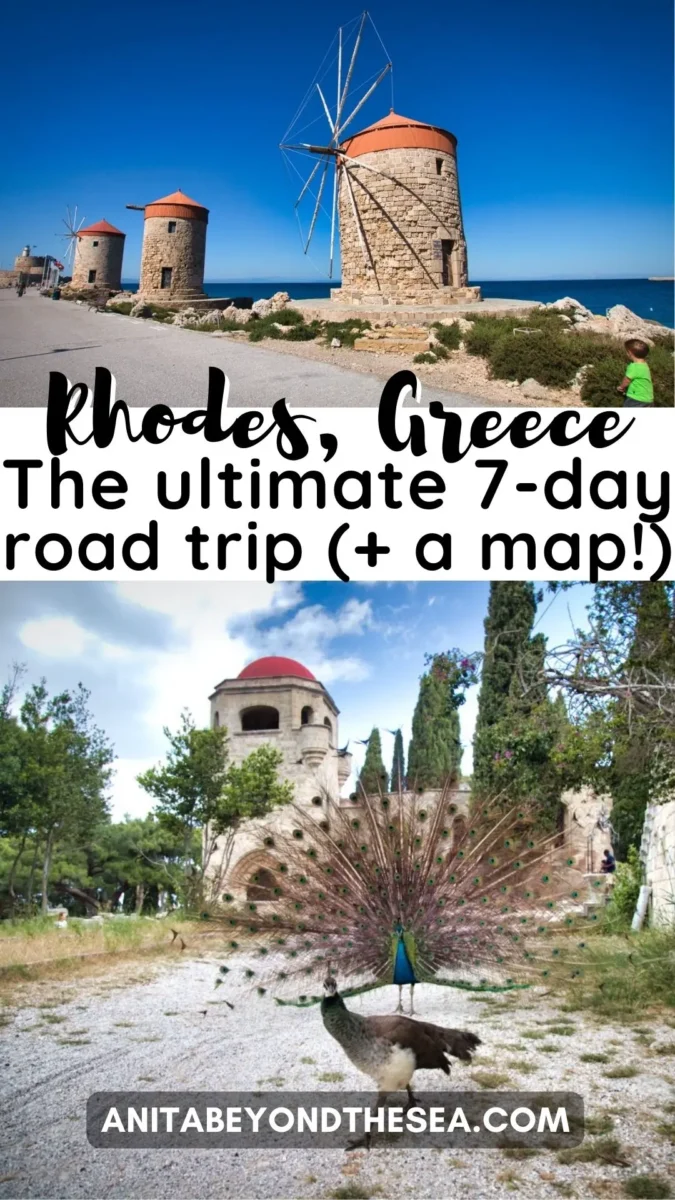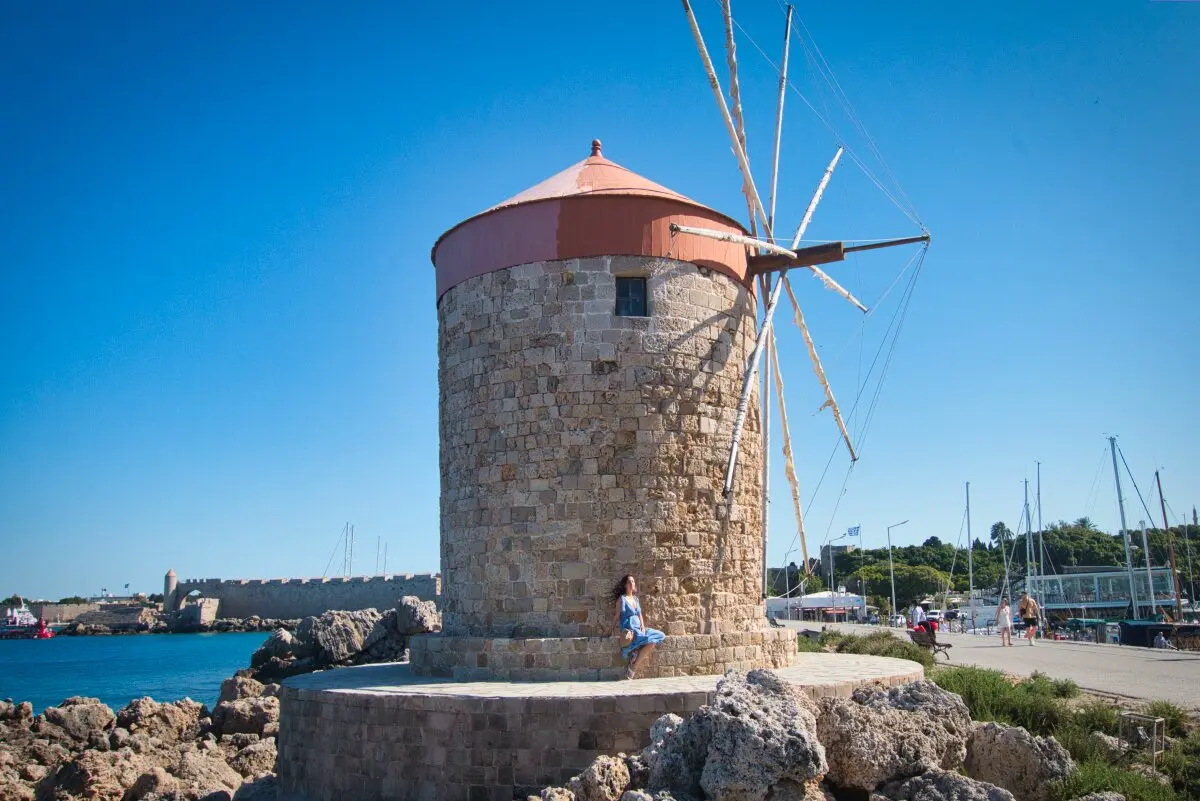There are so many activities and things to do in Rhodes that you could easily fill the planning for a 10 day stay. With a 7 day itinerary, you will be able to see the most important cultural sites and some of the most beautiful beaches that make this island one of the best to visit in the Mediterranean. This itinerary is identical to the one we used, except for the 3rd day to the south. Unfortunately, we didn’t visit Prasonisi as it’s a 3 hour round trip from Rhodes. Otherwise, you will find all our first-hand experience and some tips. Have a good read!
Disclosure: anitabeyondthesea.com is reader-supported. When you make a reservation through links on my site, I may earn an affiliate commission, at no extra cost for you. That will help me keep the blog up and running. Thank you!
In This Article
- A Map to Help You Find Your Way
- Day 1 – Rhodes Old Town
- Day 2 – Lindos and Agathi Beach
- Day 3 – Kamiros and the South
- Day 4 – Symi Island and Mandraki Harbor
- Day 5 – Eleousa, 7 Springs and Tsambika
- Day 6 – Filerimos, Butterfly Valley, and Kallithea Springs
- Day 7 – Anthony Quinn and Shopping in Rhodes Old Town
- Where to Stay in Rhodes
- How to Get Around
- How many days should I spend in Rhodes?
- In conclusion, is Rhodes worth visiting?
A Map to Help You Find Your Way
I put a lot of thought into this map so here is the final itinerary. It’s the same we did and I can confirm you that it was well optimized. Of course feel free to adjust it in case you are changing a few stops. Have a nice exploration!
Day 1 – Rhodes Old Town
I thought I had stepped on the set of an historical movie while entering the walls of Rhodes Old Town. The village looks straight out of a fairy tale with its quaint streets and Medieval buildings.
Even if partly reconstructed, the Old Town strikes for its timeless beauty and is an absolute must when visiting the island.
You could spend your day simply getting lost in the narrow streets while admiring the architecture and shops, but I highly recommend visiting the following museums and attractions.
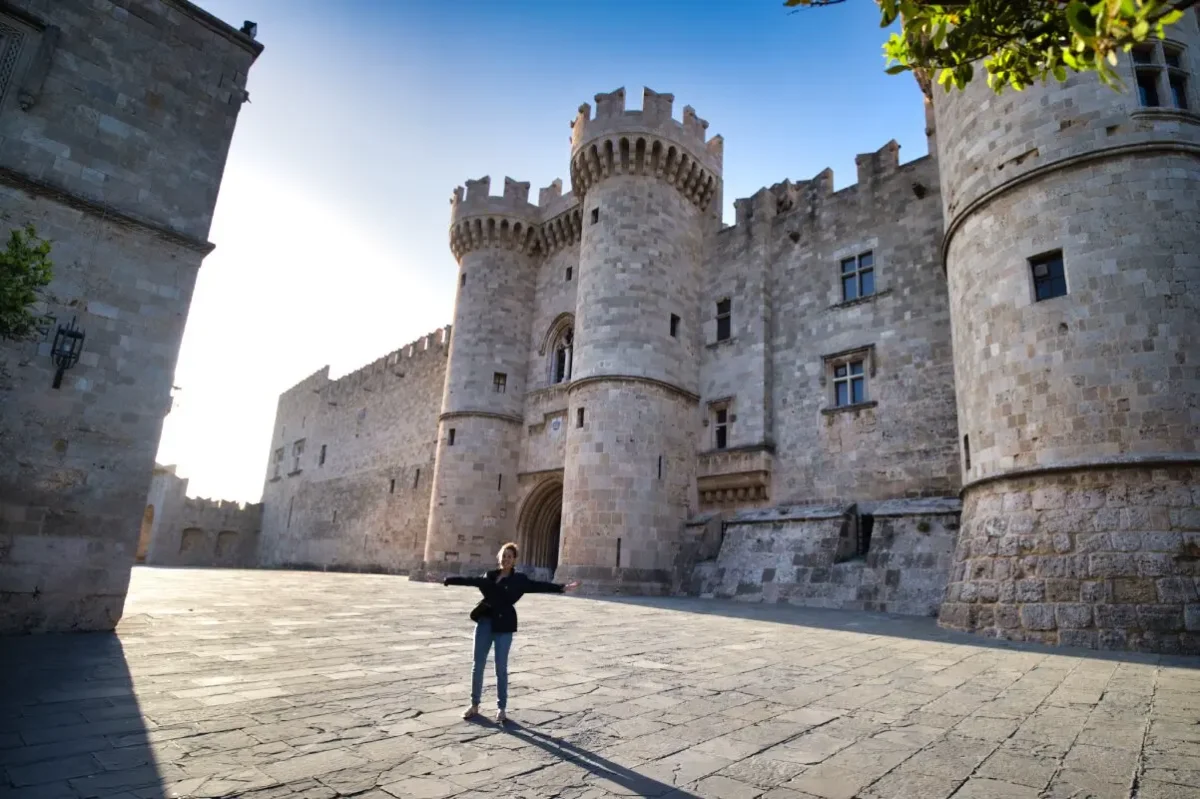
The Grand Master’s Palace
The center of power of the Knights Hospitaller, the Grand Master’s Palace was rebuilt under Italian control, after it was almost entirely destroyed in 1856 following the explosion of a gunpowder magazine.
Nowadays, the palace hosts an interesting museum where you can admire some archaeological artifacts as well as many mosaics coming from Kos island. And, of course, a section dedicated to the history of the Knights Hospitaller who ruled the island for two centuries.

Street of the Knights of Rhodes
Looking like a lost Gothic village in Central Europe, the Street of the Knights of Rhodes is a world apart. This is where the knights lived separately from the people from the village.
The knights grouped inside the many inns that sided the street alongside their guild, known as “tongue”. Nowadays, the majority of those inns are embassies or public buildings.

Archaeological Museum of Rhodes
The ancient hospital of the knights is home to Rhodes Archaeological Museum. I honestly think that the access to the building itself is well worth the small entrance fee, the solid structure in Romanesque style is one of the architectural jewels in Rhodes.
On the other hand, the collection of ancient artifacts is well worth it as well. From large vases to everyday objects from the Hellenistic period and also burial finds, it’s an interesting window on life before the Middle Age.

Medieval Clock Tower
The Medieval Clock Tower is surprisingly the highest point of Rhodes Old Town and once up there you can enjoy a beautiful view of the surroundings. Following the explosion that nearly destroyed the Grand Master’s Palace, the tower was rebuilt by the Ottomans and the clock still works to this day.
Suleymaniye Mosque
The Ottoman Empire controlled Rhodes for almost 4 centuries. And yet, surprisingly, only a few buildings survived the test of wars and time. Suleymaniye Mosque is undoubtedly the most important in the city. Unfortunately, its doors are closed except for some particular events. But you can still admire the architecture from the exterior.
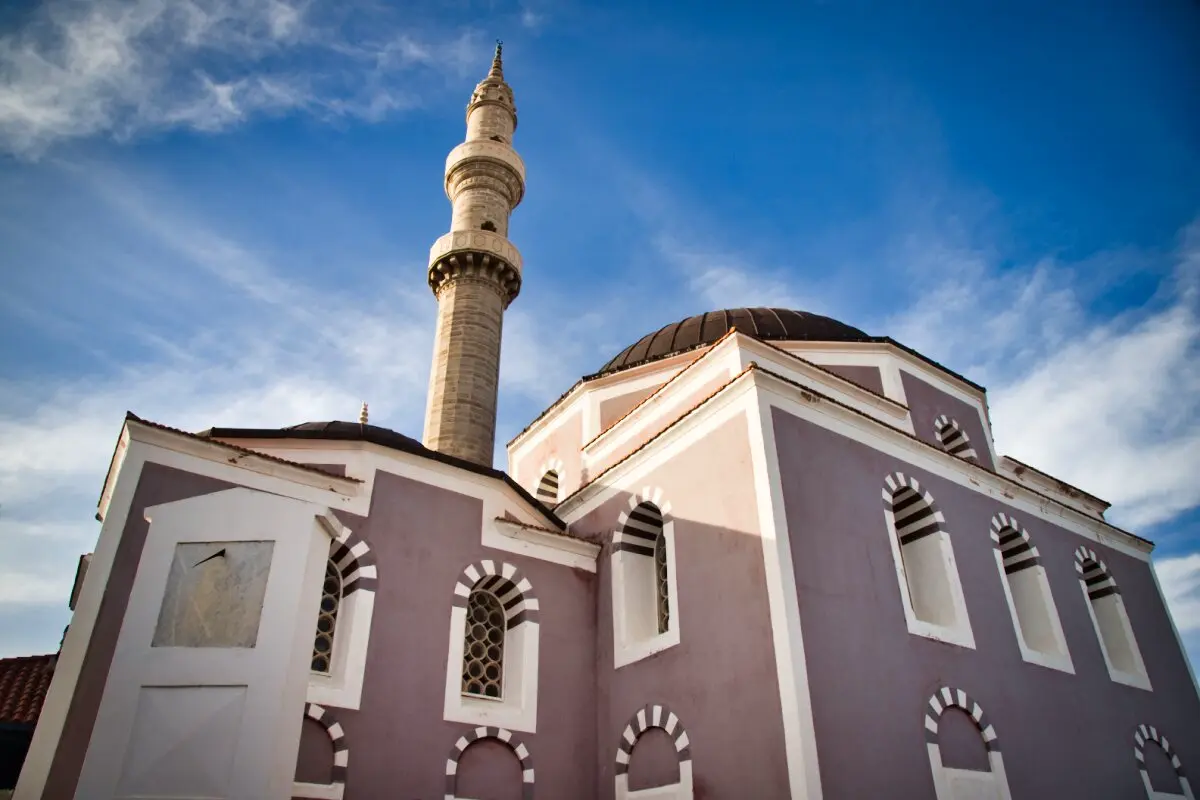
Day 2 – Lindos and Agathi Beach
The Enchanting Village of Lindos
Together with Rhodes Old Town, Lindos is the most popular place in Rhodes. It’s also the only village on the island that has the typical white squared houses that make so recognizable the most famous villages in Greece.
Lindos village is absolutely beautiful. The picturesque narrow streets are full of life and shops. It certainly is a tourist trap but still worth exploring and enjoying.

Lindos Acropolis
Towering over the village on a dramatic cliff, Lindos Acropolis is one of the most spectacular locations in Rhodes. After the tiring climb (well I’ve still made it with a stroller!) you will be rewarded with one of the most beautiful views in Rhodes.
Once you enter the Acropolis, there are millennia of history and battles unfolding under your eyes. Lindos was well known to the Greek and Roman empires, but it also has the Byzantine church of St. John and the ancient headquarters of the Knights Hospitaller.
Pro tip: Buy the tickets to the Acropolis before getting there! We learned the lesson the hard way and almost gave up entering since there was a long line (I know of people queuing for more than an hour). Luckily, thanks to the Airalo eSim data, we were able to connect to GetYourGuide and buy our tickets from there.
It’s 4€ more than the normal ticket, but you skip the line. If you have internet, or you are traveling during the low season, you can try buying them last moment at your own risk of having to wait.

St Paul’s Bay and Lindos Beach
While on top of the Acropolis, you can see Lindos Beach and St Paul’s Bay. Both are ideal to rest your sore feet, although I slightly recommend Lindos Beach as it’s more spacious compared to St Paul’s Bay. You can rent sunbeds and umbrellas in both places, but St Paul’s Bay is slightly more expensive.
The view from both beaches is insane with the Acropolis rising in the background, so if you have time, I highly recommend going down to both beaches even just to admire the view. St. Paul’s Bay is very close to the village and although it wouldn’t be my pick between the two, you should definitely check it out.
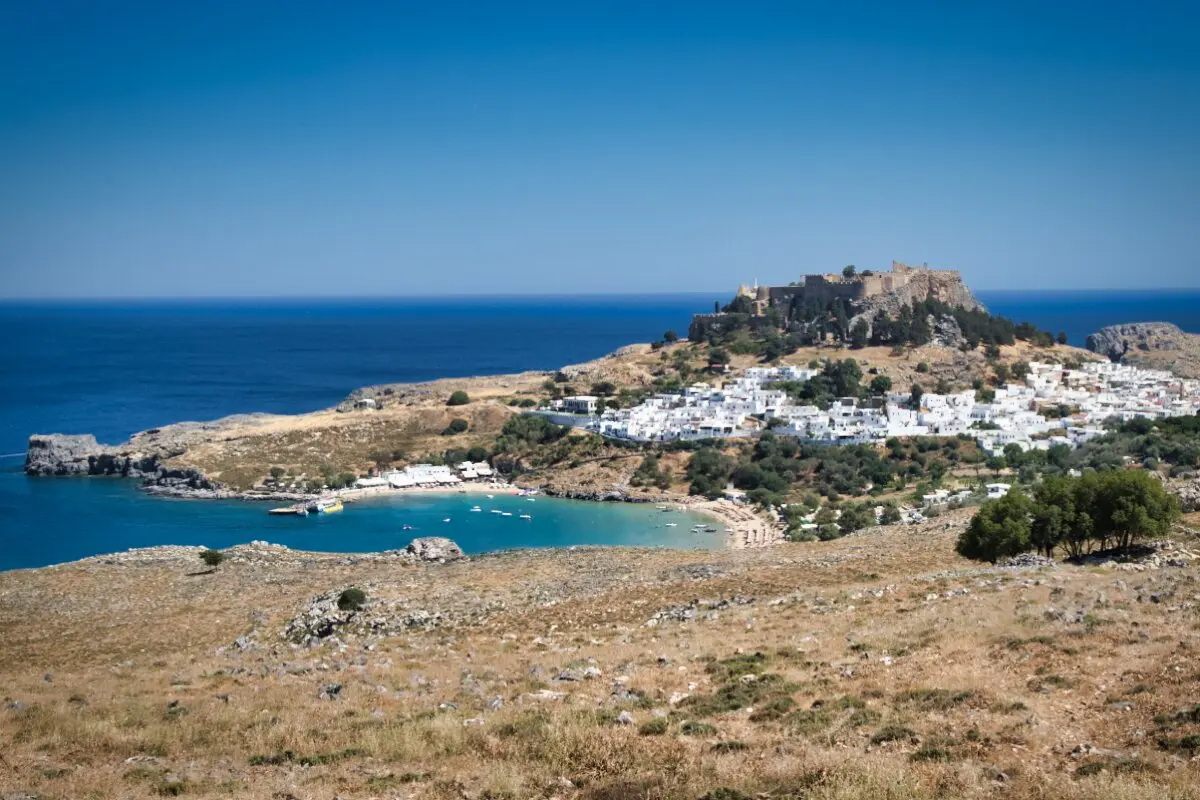
Agathi Beach
Agathi is one of the most beautiful beaches in Rhodes and my personal second favorite. If you have enough time to explore, there is an area in the north of the beach where you can snorkel and reach an arch on the rocky coast.
Note: While getting to the beach, Google maps sent us on a dirt road where we almost broke our car. When I tried the itinerary again while writing the article, it still gives you this secondary road as an option. Be careful, you may think we were clumsy, but there were three more cars who followed the same road as us. Just follow the panels to the beach and you’ll get to Agathi.
What makes this beach stand out is Feraklos castle on the right and the small church Agia Agathi Cave (Agia means church in Greek). Nearby the church on the left, you can also find a few Mycenaean tombs overlooking the beach.
If you are tired exploring you can simply lay your towel on the sand or rent a sunbed + umbrella.
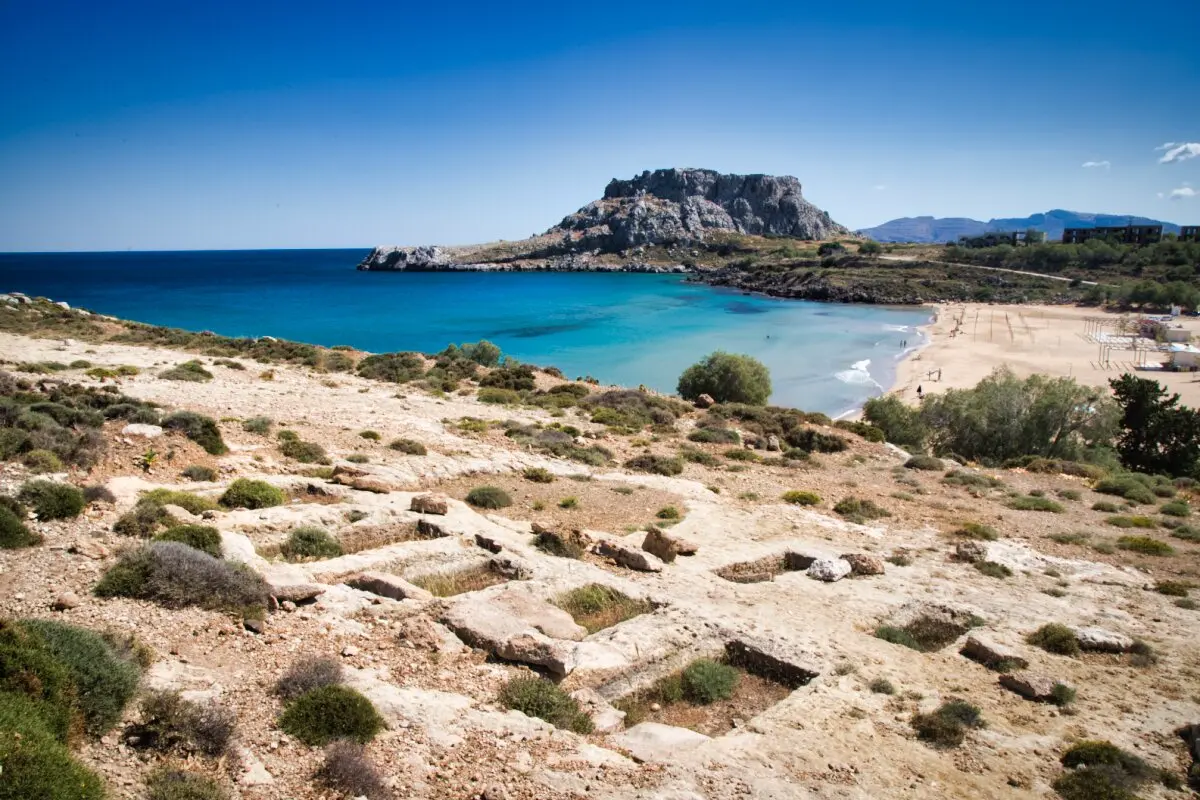
Day 3 – Kamiros and the South
The Archaeological Site of Kamiros
Kamiros is one of the largest archaeological sites in Rhodes. The unfortified Dorian city was built on three levels that are still clearly visible to this day. The site is fascinating to explore as you can see the foundations of almost all the ancient constructions.
A few explanatory panels tell the city’s story and illustrate the function of the most important buildings.

Kritinia and Monolithos Castles
After leaving Kasimiros archaeological site, take the road to the south. Along the way you’ll come across two wonderful abandoned castles: Kritinia and Monolithos. You can briefly visit them to catch the amazing views before heading to the South.
Kritinia translates from Greek as New Crete and was built during the Ottoman period. Now in heavy decline, you can enjoy one of the best views in Rhodes from the abandoned castle.
Similarly to Kritinia, Monolithos fortress is perched on a rock. The fortress was strategically located under Byzantine dominance to control the South-West coast.

Prasonisi Beach
Prasonisi is the most southern point in Rhodes connected to the mainland by a small isthmus where you will find one of the most famous beaches on the island. Due to its location, Prasonisi is very exposed to the wind, and you will almost always find kite surfers.
From Prasonisi beach you can reach the lighthouse at the end of the promontory. After a short but quite intense hike, you’ll be rewarded with a nice view of the surroundings.

Day 4 – Symi Island and Mandraki Harbor
The two ferries that do the journey daily are Nikolaos X and Sebeco. Nikolaos X is the most praised by locals. They will bring you to Panormitis by ferry. It’s slightly more expensive than the second one, but it also has a shuttle from your hotel. If you’re staying outside Rhodes, that’s an interesting service. Sebeco (the one we took) has a bus ride to Panormitis with a panoramic stop.
Remember that it’s a ferry excursion, not a guided tour, except for a few explanations on the bus to Panormitis (in Greek :D). And be punctual (in advance is even better) as they wait for no one! It seems recurrent that people lose their ride.
Eating during the visit to Symi can be rushed. I highly recommend packing lunch or be ok having lunch with an ice cream or a snack. Unfortunately, unless you are only visiting the town, there isn’t enough time to sit at a restaurant.

Symi harbor town
Symi is an island close to the Turkish coast that is about an hour (or an hour and a half depending on the ferry and weather conditions) from Rhodes harbor.
I was truly impressed by Symi and if you have enough time, I highly recommend spending at least a night there to truly enjoy the village and soak up in the welcoming ambiance. Unfortunately, we couldn’t squeeze it into our schedule, but still half a day is nice to enjoy and explore.
The town itself is very small, and there’s nothing more to do than wander in the picturesque streets, and shopping for souvenirs including the famous sponges that made the fortune of the island. Check out Kali Strata, considered one of the most beautiful streets in the town.
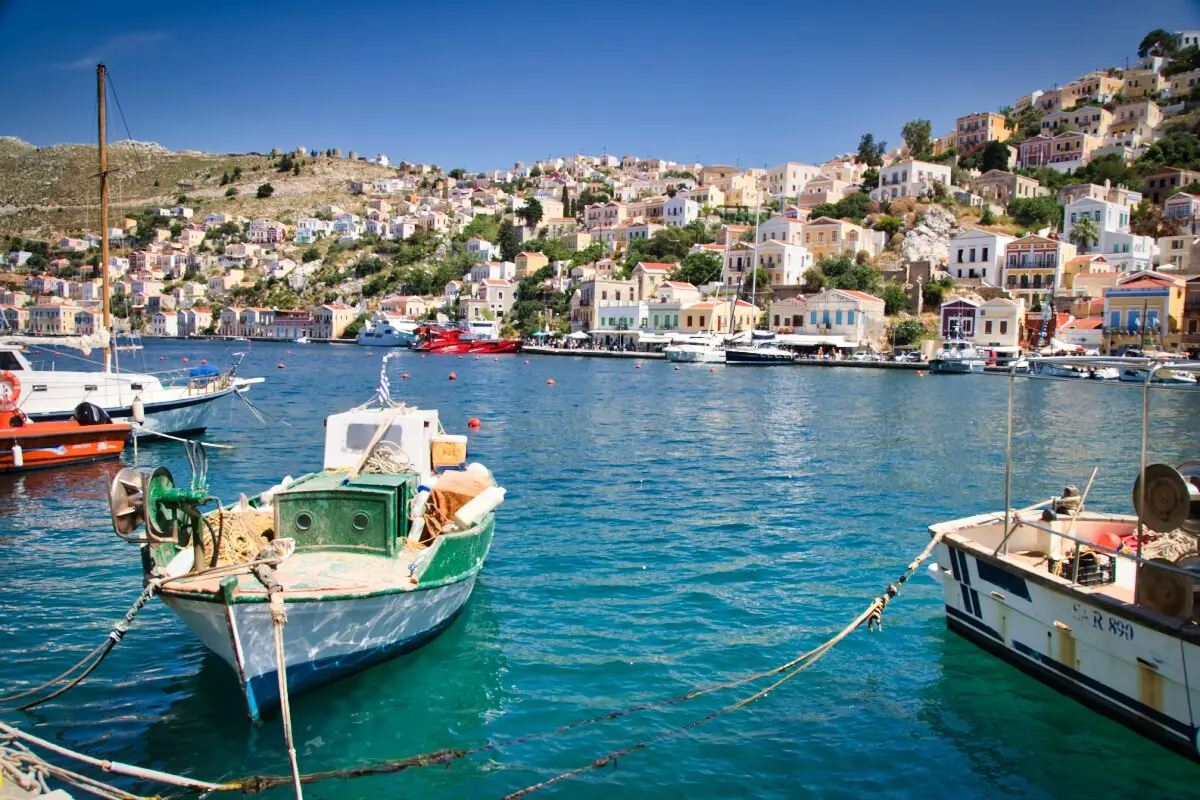
Monastery of the Archangel Michael Panormitis
If you got seasick after the ferry, you won’t be happy getting on board a bus for half an hour to crossing the island on winding streets. But trust me it’s absolutely worth it! The bus stops along the way to let you admire the views of the island and there are explanations about the history of the island (in Greek unfortunately).
The Monastery of Panormitis is perfectly located at the center of a nice bay guarded by a lighthouse and the scenery is breathtaking. You have about an hour to explore the monastery and admire the venerated icon of the Archangel Michael.
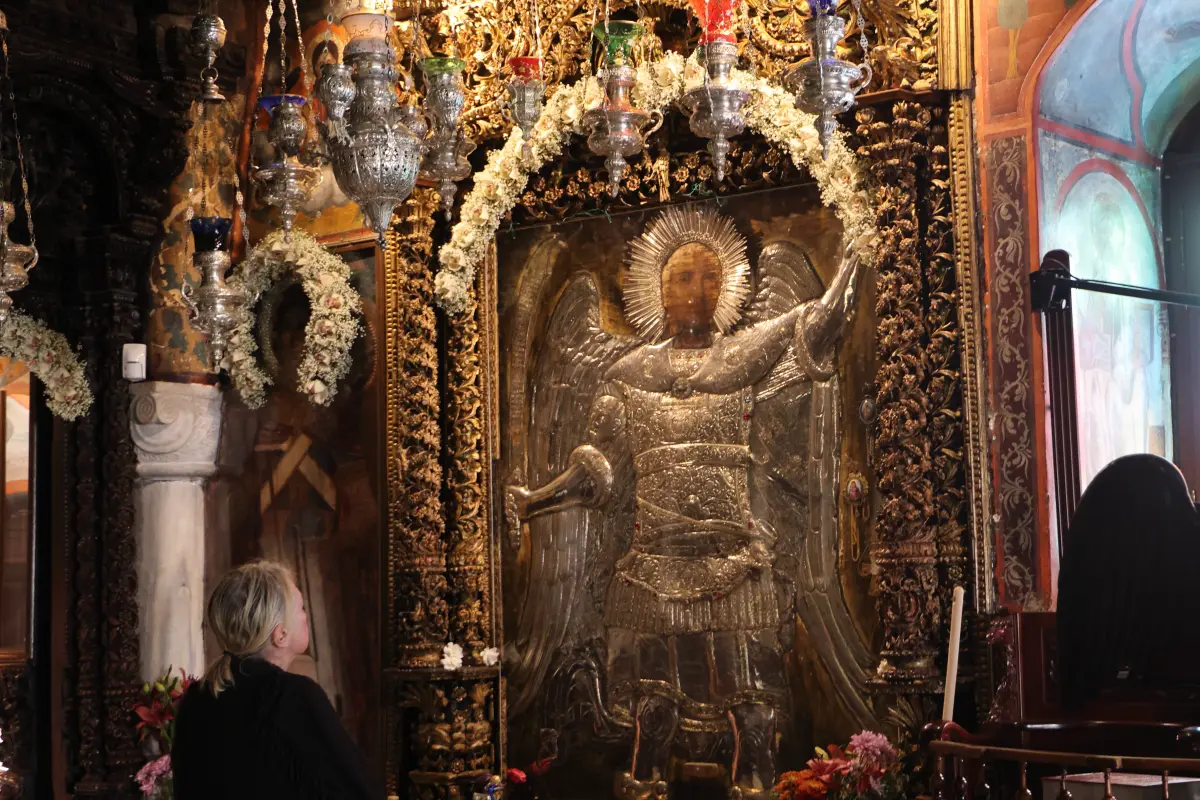
Mandraki Harbor in Rhodes
Back to Rhodes unless you have a drop-off, take the time to explore Mandraki harbor. The location is one of the most picturesque in Rhodes for two main reasons:
- The stag and doe statues that replaced the famous Colossus.
- The three photogenic windmills on the promenade.
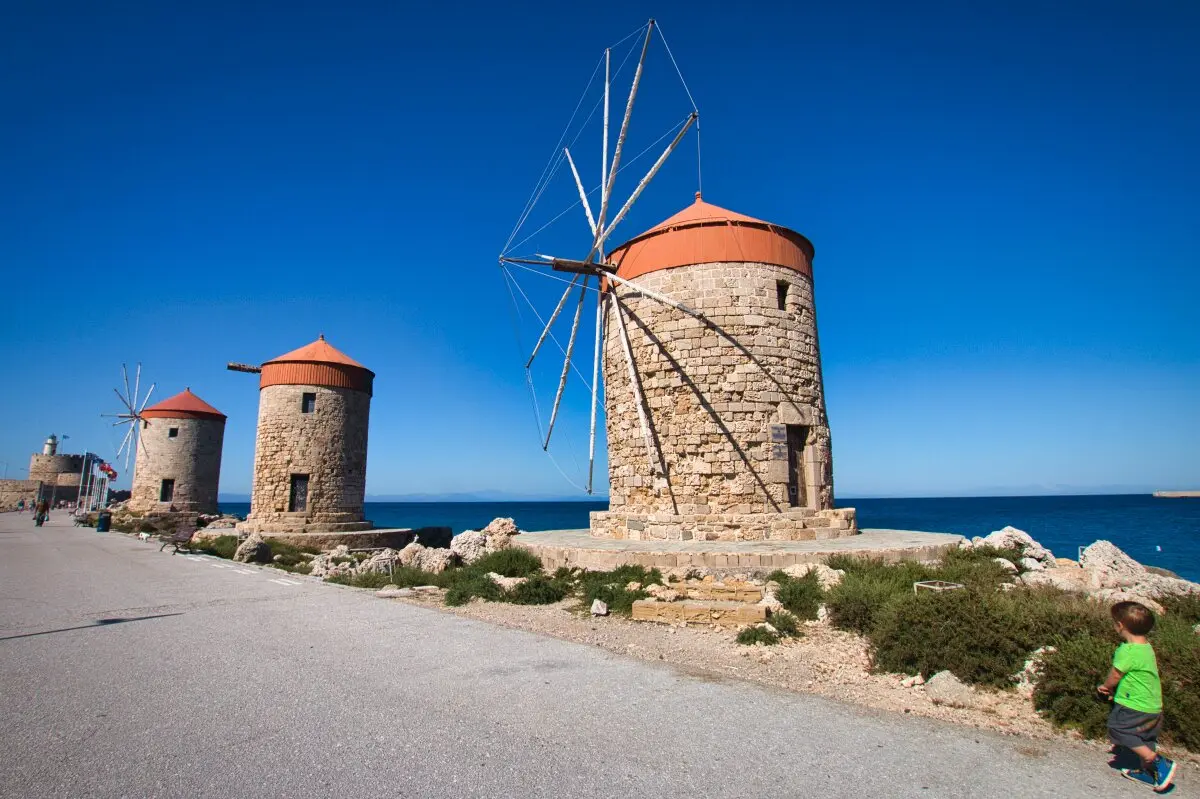
Day 5 – Eleousa, 7 Springs and Tsambika
The Italian Urbex of Eleousa
Known as Campochiaro under Italian dominance, Eleousa is a municipality in the center of Rhodes where you can find some of the finest urbex on the island.
Disclaimer: As for any time you are exploring urbex, venture forth responsibly, carefully, and within the boundaries of law.
Siding a rectangular square, you will find four buildings:
- Amid the ruins, Karalampos Church feels out of place. Its perfectly curated exteriors are in sharp contrast with the rest of the abandoned constructions. The church is also situated on top of a small hill with a large stair in the front which gives it an imposing allure despite its small size.
- Facing the church there is an abandoned administration building that has been repurposed as a school in the 60s – 70s. The structure is on 2 accessible floors (and I guess one closed underneath). From the external terrace, you can admire a nice view of the surroundings.
- The building on the left of the church is definitely the most intriguing. Once used to host shops, and probably a few apartments, it even has a projection room on the second floor. You can still see the white wall to see the movies. It’s unknown if it was when the building served as a sanatorium in the 70s or during the Italian period.
- On the right of the church, the white building was once a school and is partly used today by the firemen who store some equipment there. The building is closed to the public.
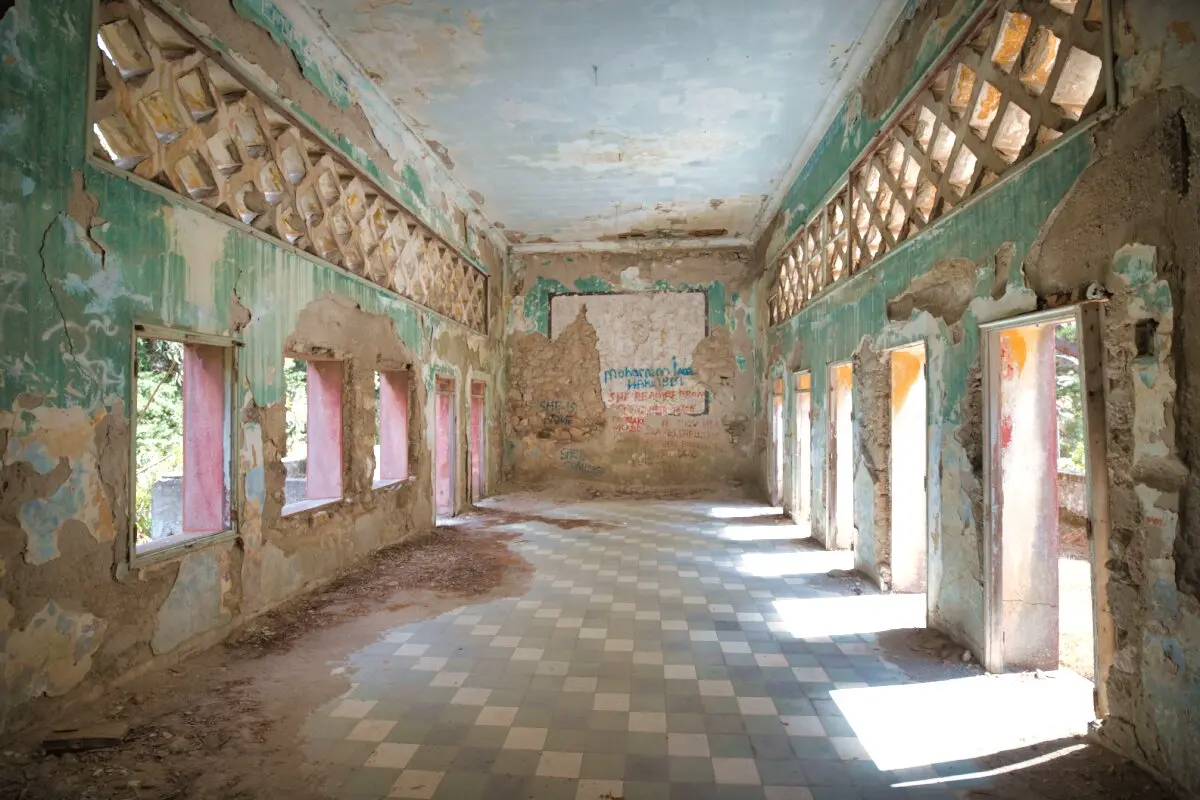
The Abandoned Elafos Hotel and Villa Mussolini
Under the Italian occupation, the area of Eleousa and Prophet Elias Hill were colonized by people coming from Trentino Alto Adige, Italy’s North East. Imagine the surprise of finding a Tyrolean style hotel in the middle of a Greek island!
Elafos Hotel was a complex of two elegant hotels that were active during the Italian domination. One of the two is still active, while the second one has been abandoned, and you can CAREFULLY visit. Although an area is locked for storage.
Last urbex of the day is the haunting Villa Mussolini. A few meters away from the two hotels, you can see the once majestic villa is still abandoned. Dictator Mussolini himself never lived inside the villa, but Count Cesare de Vecchi ruled Rhodes with an iron fist for more than a decade.
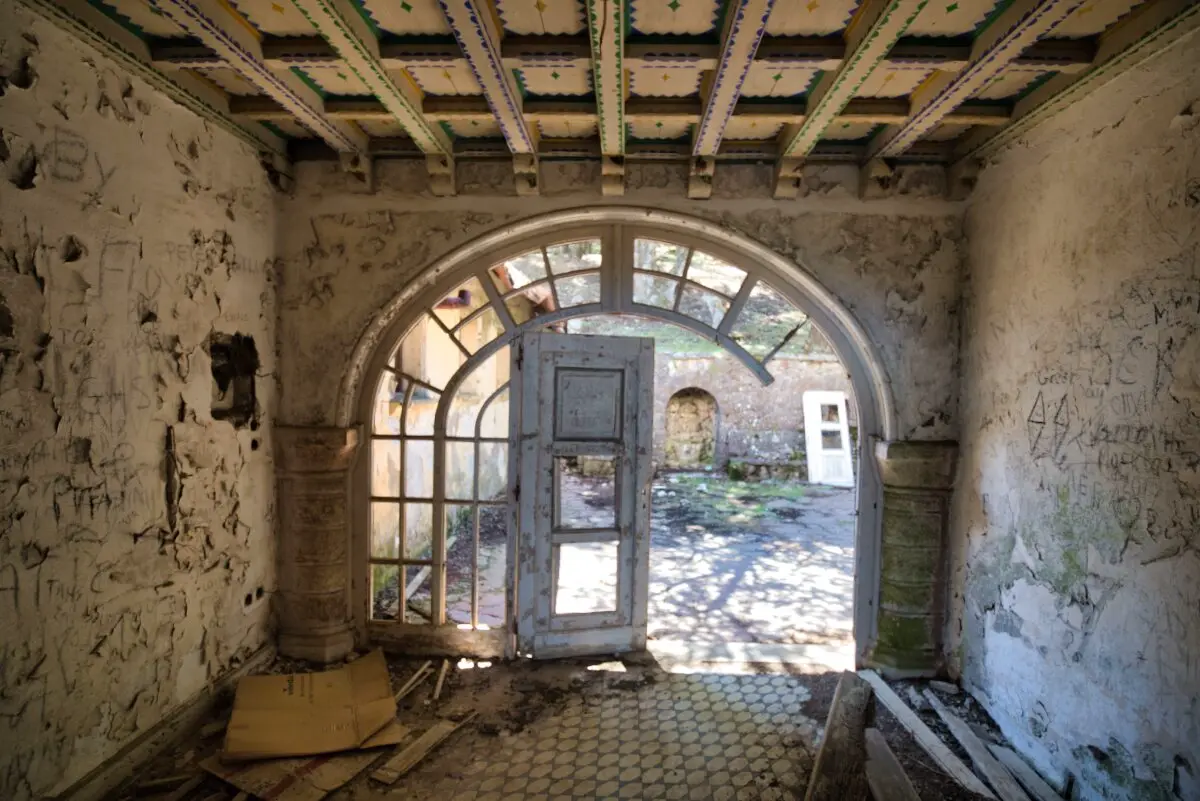
The 7 Springs
Epta Piges, the Seven Springs are famous because of the man-made waterfall that attracts tourists as a background for Instagram shots. Although the coolest part is the 500 ft (150 mt) long and 8,20 ft (2,5 mt) high water channel dug by the Italians where you can walk in absolute darkness.
I absolutely loved the experience of walking in complete darkness just leaning on the walls to go on. It’s way easier than it seems! The hardest part? Getting your feet into the cold water. Of course, if you are claustrophobic, you should sit this one out.
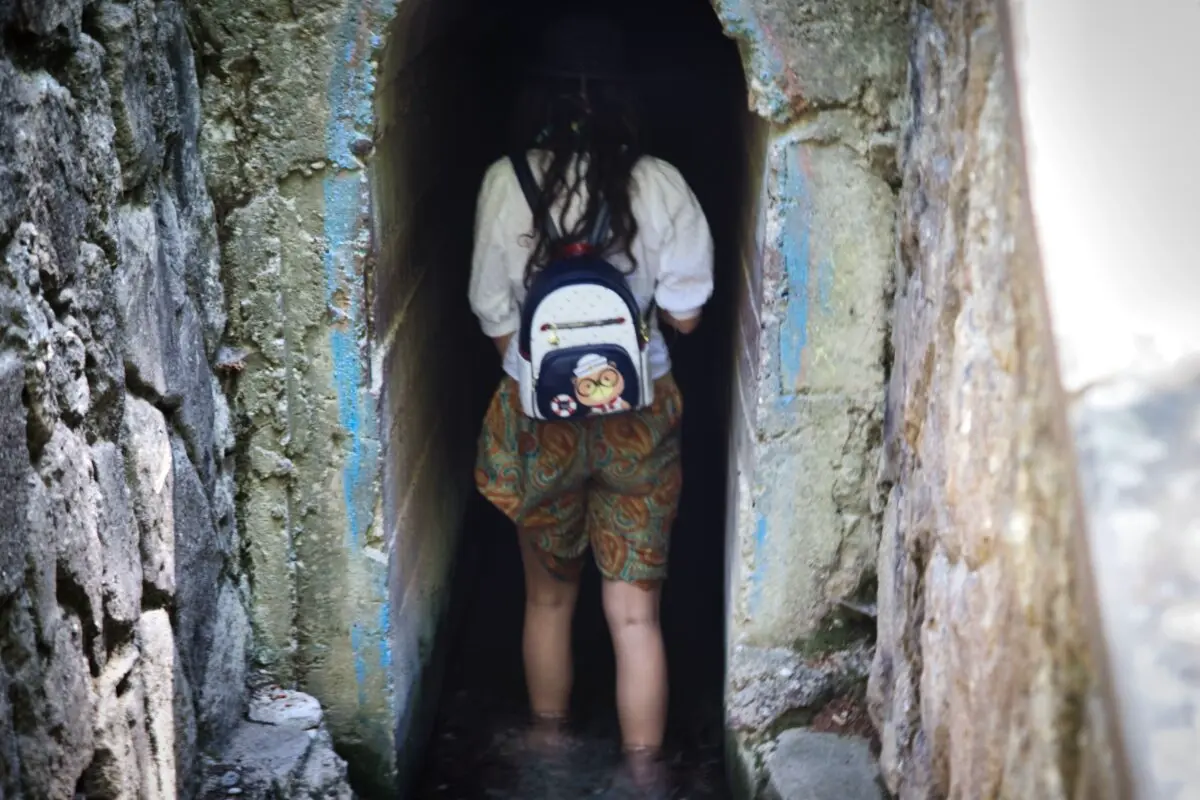
Tsambika Beach
I loved Tsambika as you can simply lay down and enjoy the amazing scenery and sun while bathing, or you can try water sports for an honest fee. The location is spot on also for snorkeling.
What’s great about this beach is the fact that, besides being one of the most beautiful in Rhodes, you still have the choice between paying for an umbrella and sunbed or just bringing your own towel. The beach is also very spacious and even if it can be crowded there’s a lot of space for everyone.
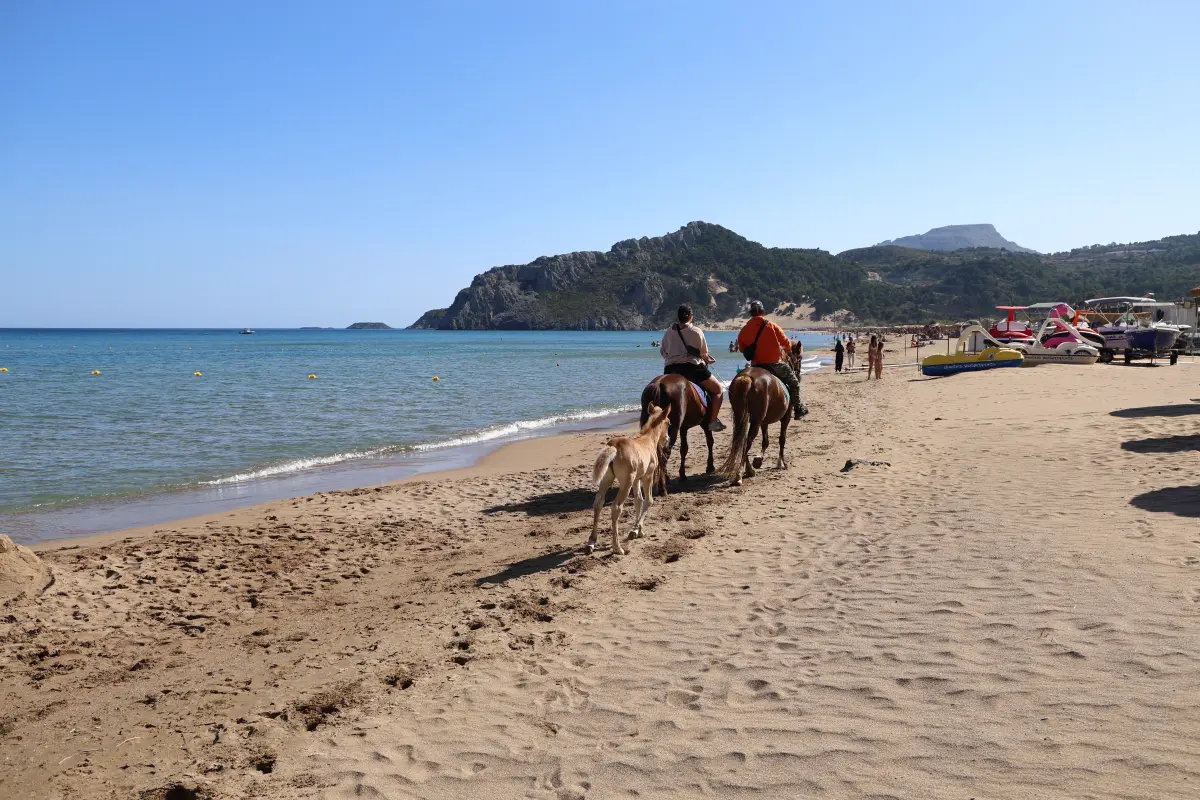
Day 6 – Filerimos, Butterfly Valley, and Kallithea Springs
Filerimos Monastery
Is one of the most important archaeological sites on Rhodes. Situated on a plateau at 875 ft (267 mt), the area delights its visitors with the remains of the ancient acropoli of Ialissos and of the Byzantine period, as well as the unobstructed views of the Western side of Rhodes, the Turkish coast, and Symi.
Filerimos is also a peacock paradise. You can observe the colorful males continuously parading to attract the females’ attention as well as the tourists’ favors in the form of treats. By the way, I’m still owed the croissant they stole from me!
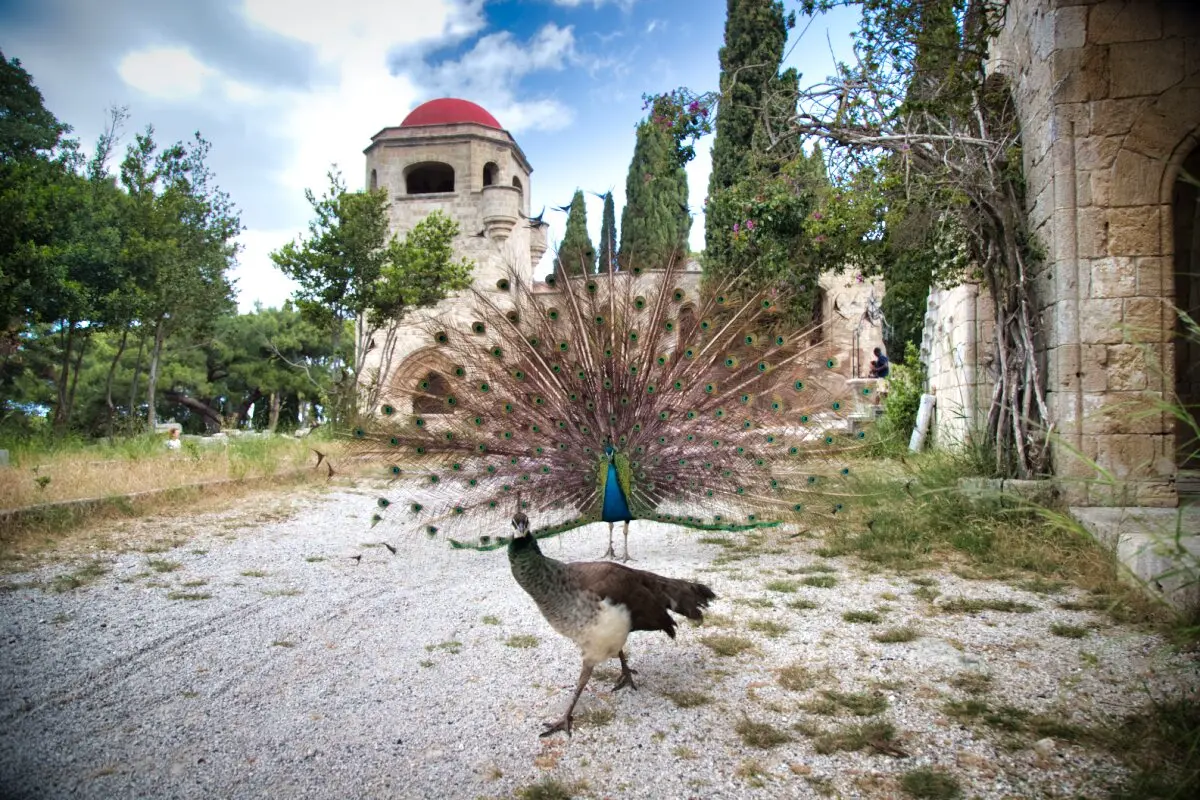
Farma of Rhodes Pet Zoo
I could bring my husband to the most incredible places, and yet if you ask him what was your favorite part of our trip, he will tell you Rhodes Pet Zoo. Well, I totally get him, I mean, I petted lemurs and ostriches. How cool is that?!
Anyways, traveling with kids, this stop was a must for us, and I’m really happy we took a break from the sightseeing and cultural activities to connect with the adorable pets of this farm. It’s a good way to occupy an hour or two depending of your travel companions. Animal lovers, this stop is a must for you!
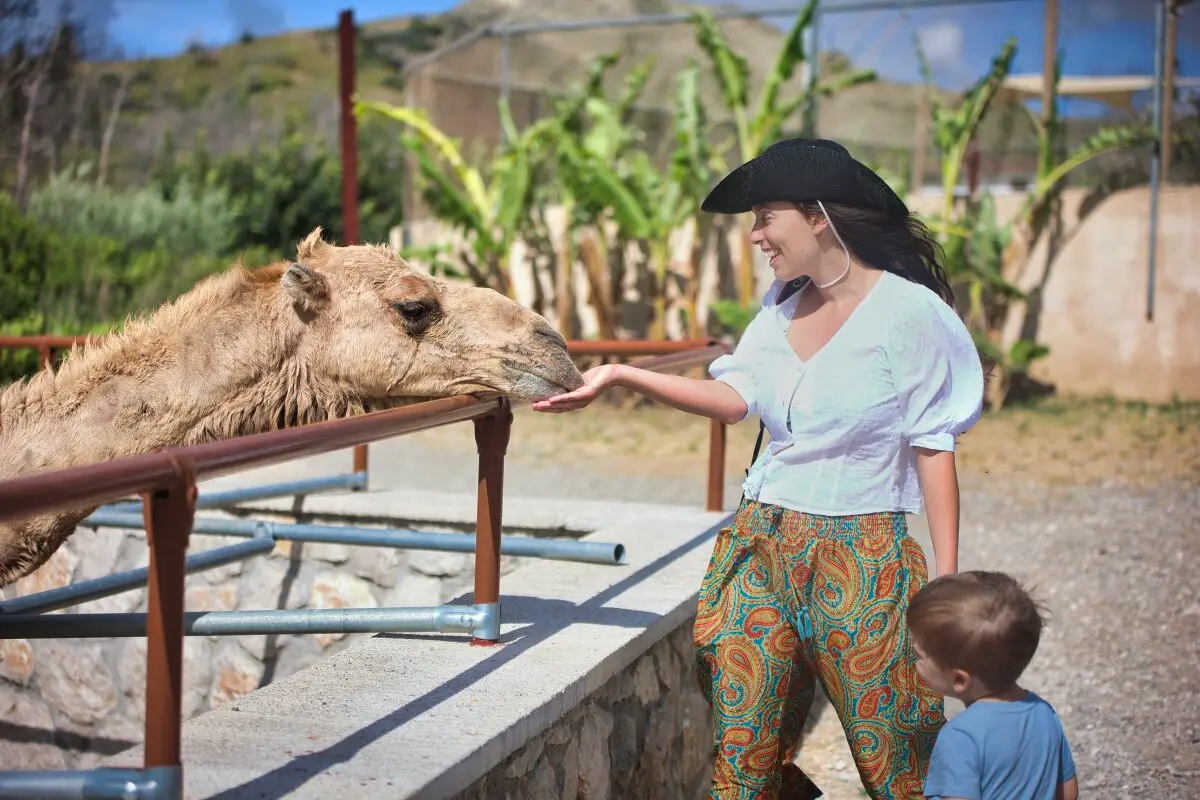
Butterfly Valley
The butterfly valley can be a huge deception if you are visiting in the wrong period. In fact, the moths (yes they are not butterflies) are there from late June to September. Outside this period, you normally won’t see them. Also, through the years, due to tourism, there are fewer moths in the valley.
The hike is still nice but may be deceiving if you don’t have the information above. One last tip : when you’re considering buying a souvenir from Rhodes, remember that there are only moths in the Butterfly valley. I saw many framed butterflies sold in a few shops stating they are from the valley. That’s simply false!
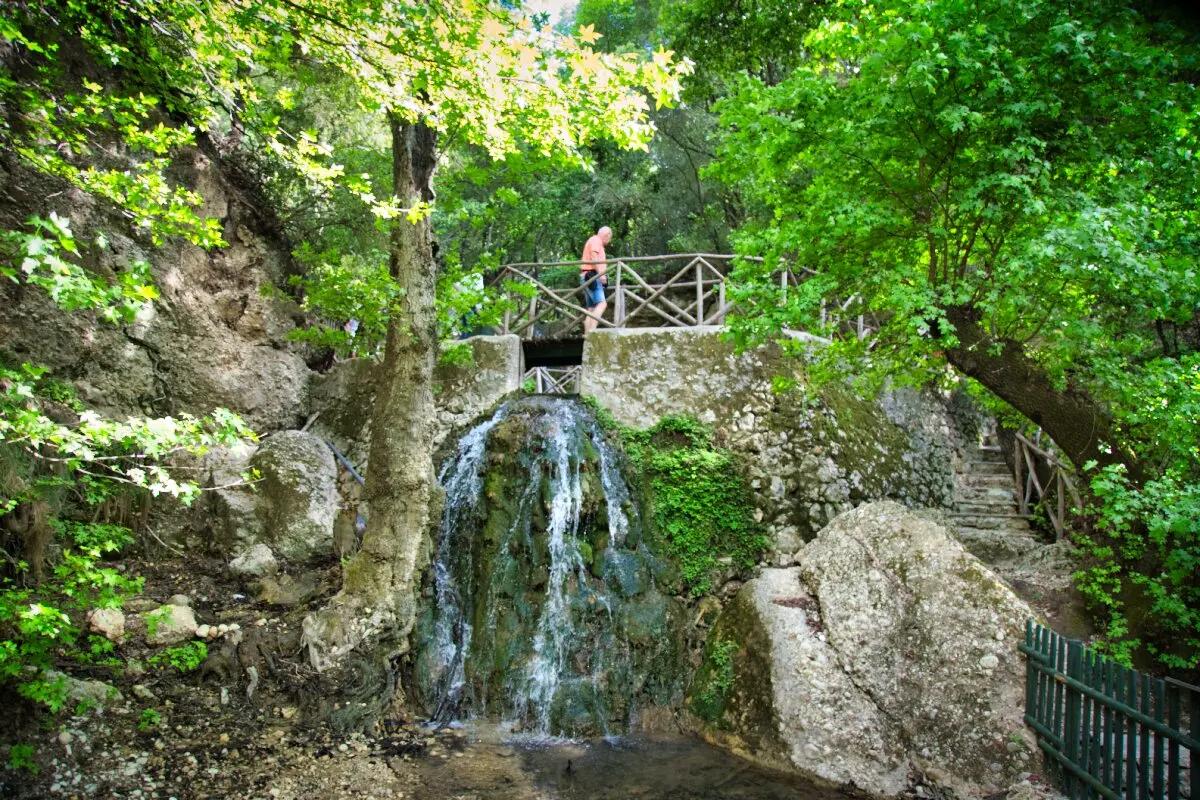
Kallithea Springs
Kallithea Spring is a stunning art déco complex built under Italian domination. It also has a rocky beach with sunbeds and a very short area (I’d say about 30 feet less than 10 meters) where there are pebbles to make your descent into the water easier.
The place is a pleasant discovery even if you are not bathing. And paying for the entry ticket even to wander is absolutely worth it!

Day 7 – Anthony Quinn and Shopping in Rhodes Old Town
Profitis Ilias Church and the Abandoned WWII Bunker
Profitis Ilias Church is located on top of the peak between Faliraki and Anthony Quinn Bay. The church is very small and quaint, but, the real deal is the view, one of the best in Rhodes! On your left you will see Faliraki and even Kallithea area, while on your right you will see Anthony Quinn Bay, Ladiko Beach, and a third very small bay that is accessible only by boat.
Before leaving, the bravest can enter the abandoned bunker very close to the viewpoint of Anthony Quinn’s bay.

Anthony Quinn Bay
Famous actor Anthony Quinn fell in love with the bay and bought it. But, luckily for us, in 1984 the Greek government took it back and made it public. Nowadays, the bay is undoubtedly one of the most beautiful in the Dodecanese islands (my personal favorite in Rhodes) and attracts several tourists every year.
The beach is made of pebbles and a rocky seabed. Neoprene shoes are ideal for your comfort also because of seaweed making the soil a bit slippery in some points.
You can rent an umbrella and a sunbed or just lay your towel where you prefer. There is also a terrace restaurant if you don’t want to bring your own food.

Shopping in Rhodes Old Town
I recommend visiting Anthony Quinn Bay first as it gets very crowded early and leaving shopping for the afternoon. Of course, shopping is an excuse to enjoy Rhodes Old Town once again.
Besides the usual kitsch for family and friends, there a few products worth bringing home.
- Olive soap is a very good moisturizer, antioxidant, and is rich in vitamins E and A.
- Rhodian ouzo is a liqueur similar to French pastis, made from anise.
- For real gourmands (like me! ;)) Loukoumi are some kind of soft fruit jelly, very sweet and delicious.
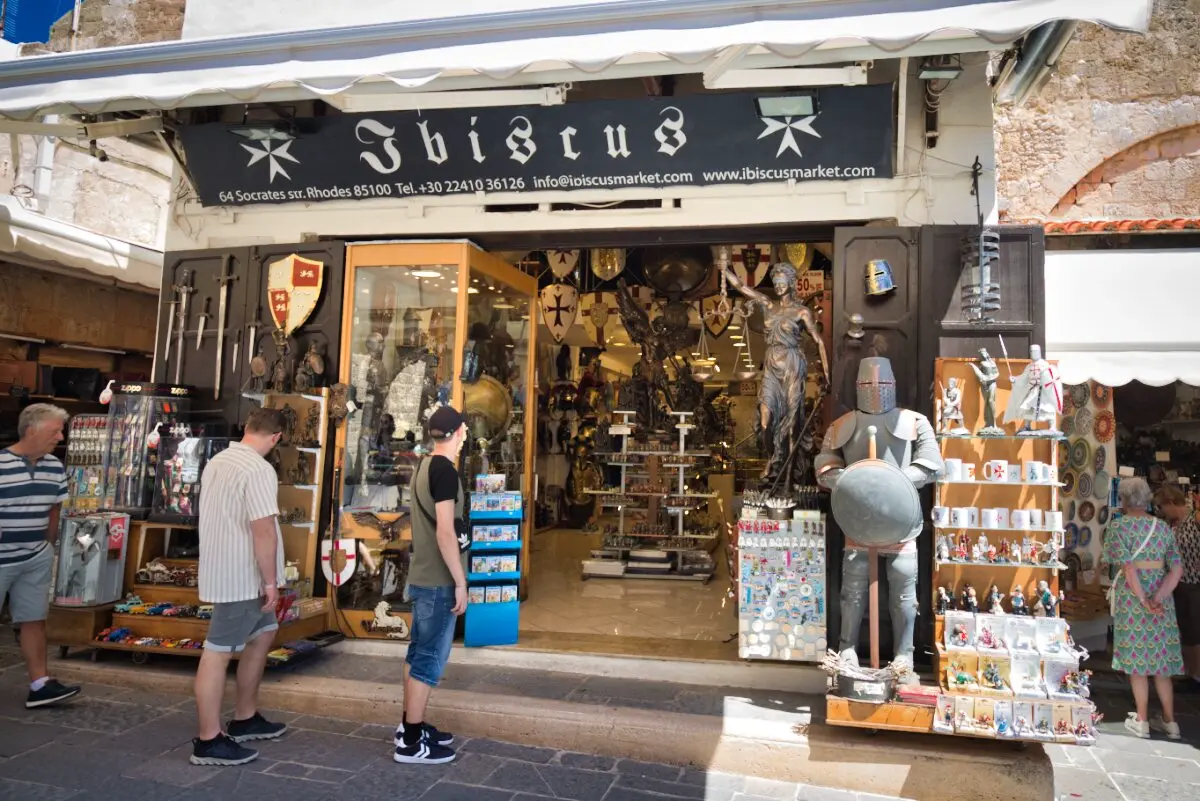
Where to Stay in Rhodes
There are some beautiful resorts on the Eastern coast, especially in Faliraki area, which also have very nice beaches nearby.
But honestly, staying in Rhodes center is more practical. During summer parking can be a pain, but it’s still ideal to enjoy the best restaurants in Rhodes city and old town, and practical when you take the ferry to Symi. And let’s be honest, how cool is it to sleep in the walls of a Medieval city?
Check the best hotels in Rhodes Old Town on Booking
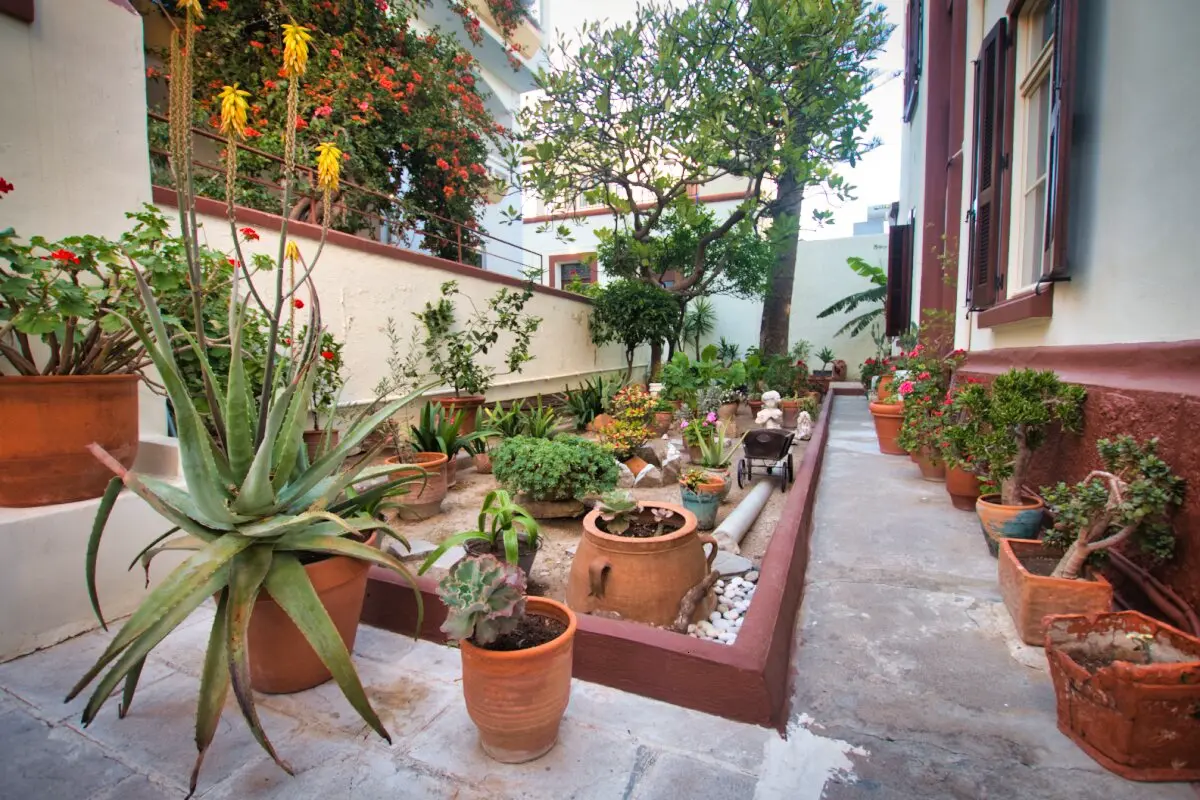
How to Get Around
Having a car is the best option to explore the island. There are simply no other options to get at some of the popular beaches and points of interest mentioned above, unless you are visiting with guided tours or taking a taxi.
As always when I’m traveling, I trust discovercars.com. They rely on local companies and have plenty of cars to choose from. Down below you can easily simulate or book with your travel dates.
How many days should I spend in Rhodes?
I think you could easily fill out your program for a 10 day stay. Including spending a day and a half in Symi and adding Chalki to my itinerary. Otherwise, I strongly advise spending at least 1 week. The island is beautiful, the food is great, and there are so many things to do!
In conclusion, is Rhodes worth visiting?
It absolutely is! Rhodes is a well known and appreciated destination, and it’s easy to see why! Also, the economy of the island is almost solely based on tourism. For this reason, locals are very kind to tourists and always willing to help.
Have you liked our Rhodes itinerary? Sharing is caring!
